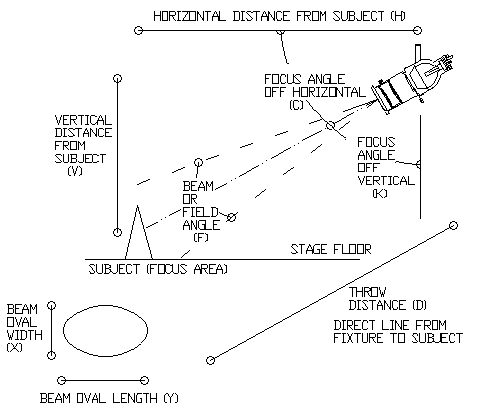The following
is a collection of math formulas that can prove useful to
lighting designers and electricians. If you have any others
that would be helpful,
email
them to us and we'll add them.
If you
experience difficulty downloading these files please contact
us.
You can
also download a simple spreadsheet that has several useful
lighting calculations built into it:
Lgtcalc1 for Excel'97 (26K)
--
Lgtcalc3 for Excel 3.0 (30K)
--
Click on your selection, then choose "Save As" from your
browser "File" menu.
We are working on other down load file formats for this
spreadsheet.
power:
Watts = Volts * Amps
Amps = Watts / Volts
Sine Wave (VAC):
RMS Volts =
0.707 x Peak Volts
RMS Volts = 1.11 x Average Volts
Peak Volts = 1.57 x Average Volts
Peak Volts = 1.414 x RMS Volts
Average Volts = 0.637 x Peak Volts
Average Volts = 0.9 x RMS Volts
DC voltage
drop of conductor (cable) of L length
V = voltage
drop, I = current
R = resistance of conductor per 1000 feet
L = length of conductor in feet
R for 18awg = 6.51, 16awg = 4.09, 14awg = 2.58
12awg = 1.62, 10awg = 1.02, 8awg = 0.64
V = I * L * (R / 1000) * 1.004
Unit
conversions:
inches = millimeters / 25.4
millimeters = inches * 25.4
feet = meters / 0.3048
meters = feet * 0.3048
footcandles = lux / 10.8
lux = footcandles * 10.8
Centigrade = 0.556 * (Fahrenheit - 32)
Fahrenheit = 1.8 * (Centigrade + 32)
pounds = kilograms * 2.205
kilograms = pounds * 0.454
degrees = 180 * radians / PI
radians = PI * degrees /180
Pattern
projection magnification and required pattern size:
A = new pattern size, B = old pattern size,
C = new projection size, D = old projection size
P = projection magnification
for standard AQ61 (or Altman 360Q) ellipsoidals, consider old
pattern size to be 3" (size of gate), and old projection size
to be the beam spread using the field angle information. Check
diameter of gate (shutter plane opening) for other fixtures.
A = B *
(C/D)
P = D / B
distances,
intensities, spreads, and angles:

As seen in
the drawing to the right:
D = throw distance, V = vertical height, H = horizontal
distance,
C = focus angle off horizontal, K = focus angle off vertical,
F = beam or field angle of fixture
X = beam spread (beam oval width), Y = beam oval length
mf = beam spread multiplying factor
Footcandles:
Footcandles = Candlepower / (D * D)
Candlepower:
Candlepower =
Footcandles * (D * D)
Beam angle
multiplying factor (mf):
mf = 2 * TAN(F / 2)
mf = X / D
Beam angle
(F):
F = 2 *
ATAN(mf / 2)
F = 2 * ATAN(X / (2 * D) )
Beam spread
(oval width X if not straight on):
X
= D * (2 * TAN(F / 2))
X = D * mf
Beam oval
length (Y) (when beam hits surface at angle):
Y = V * (
TAN(K + F/2) - TAN(K - F/2) )
Throw distance (D):
D = X / mf
D = SQUARE ROOT( (V * V) + (H * H) )
D = H / COS(C)
D = V / SIN(C)
D = H / SIN(K)
D = V / COS(K)
D = SQUARE ROOT(Candlepower / Footcandles)
Horizontal distance (H):
H = SQUARE ROOT( (D * D) - (V * V) )
H = V / TAN(C)
H = D * COS(C)
H = D * SIN(K)
H = V * TAN(K)
Vertical height (V):
V = SQUARE ROOT( (D * D) - (H * H) )
V = H * TAN(C)
V = D * SIN(C)
V = D * COS(K)
V = H / TAN(K)
Focus angle off horizontal (C):
C = ATAN(V / H)
C = ASIN(V / D)
C = 90 - ASIN(H / D)
C = 90 - K
Focus angle off vertical (K):
K = ATAN(H / V)
K = ASIN(H / D)
K = 90 - ASIN(V / D)
K = 90 - C
